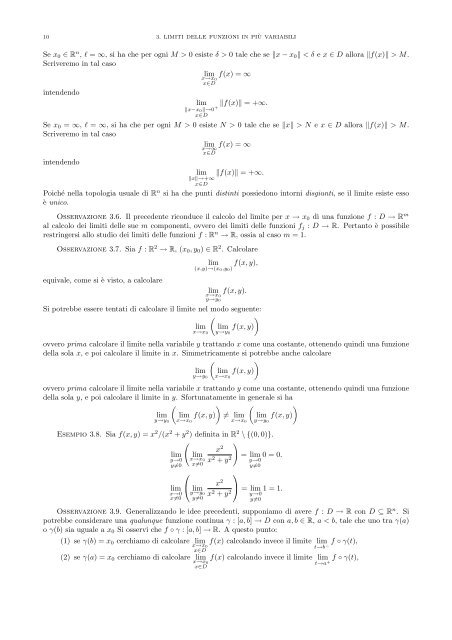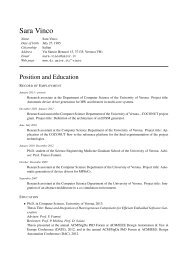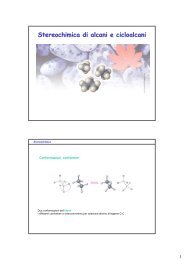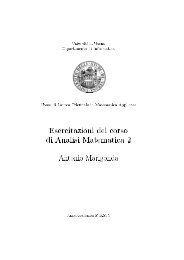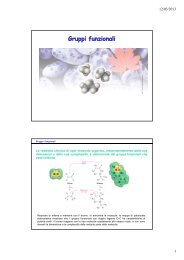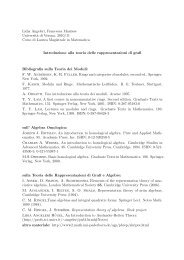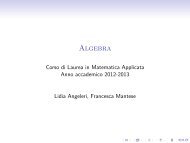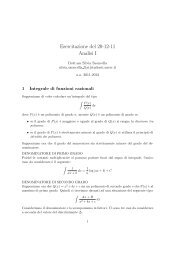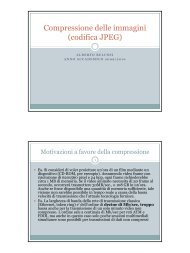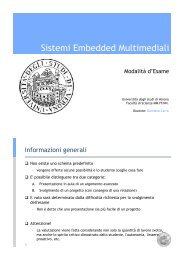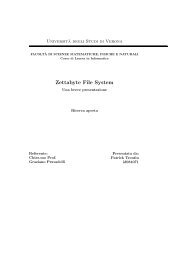You also want an ePaper? Increase the reach of your titles
YUMPU automatically turns print PDFs into web optimized ePapers that Google loves.
<strong>10</strong> 3. LIMITI DELLE FUNZIONI IN PIÙ VARIABILI<br />
Se x0 ∈ Rn , ℓ = ∞, si ha che per ogni M > 0 esiste δ > 0 tale che se x − x0 < δ e x ∈ D allora f(x) > M.<br />
Scriveremo in tal caso<br />
lim f(x) = ∞<br />
intendendo<br />
x→x0<br />
x∈D<br />
lim<br />
x−x0→0 +<br />
x∈D<br />
f(x) = +∞.<br />
Se x0 = ∞, ℓ = ∞, si ha che per ogni M > 0 esiste N > 0 tale che se x > N e x ∈ D allora f(x) > M.<br />
Scriveremo in tal caso<br />
lim f(x) = ∞<br />
intendendo<br />
x→∞<br />
x∈D<br />
lim<br />
x→+∞<br />
x∈D<br />
f(x) = +∞.<br />
Poiché nella topologia usuale di R n si ha che punti distinti possiedono intorni disgiunti, se il lim<strong>it</strong>e esiste esso<br />
è unico.<br />
Osservazione 3.6. Il precedente riconduce il calcolo del lim<strong>it</strong>e per x → x0 di una funzione f : D → R m<br />
al calcolo dei lim<strong>it</strong>i delle sue m componenti, ovvero dei lim<strong>it</strong>i delle funzioni fj : D → R. Pertanto è possibile<br />
restringersi allo studio dei lim<strong>it</strong>i delle funzioni f : R n → R, ossia al caso m = 1.<br />
Osservazione 3.7. Sia f : R 2 → R, (x0, y0) ∈ R 2 . Calcolare<br />
equivale, come si è visto, a calcolare<br />
lim f(x, y),<br />
(x,y)→(x0,y0)<br />
lim<br />
x→x0<br />
y→y0<br />
f(x, y).<br />
Si potrebbe essere tentati di calcolare il lim<strong>it</strong>e nel modo seguente:<br />
<br />
<br />
lim lim f(x, y)<br />
x→x0 y→y0<br />
ovvero prima calcolare il lim<strong>it</strong>e nella variabile y trattando x come una costante, ottenendo quindi una funzione<br />
della sola x, e poi calcolare il lim<strong>it</strong>e in x. Simmetricamente si potrebbe anche calcolare<br />
<br />
<br />
lim lim f(x, y)<br />
y→y0 x→x0<br />
ovvero prima calcolare il lim<strong>it</strong>e nella variabile x trattando y come una costante, ottenendo quindi una funzione<br />
della sola y, e poi calcolare il lim<strong>it</strong>e in y. Sfortunatamente in generale si ha<br />
<br />
<br />
<br />
lim<br />
y→y0<br />
lim f(x, y)<br />
x→x0<br />
= lim<br />
x→x0<br />
lim f(x, y)<br />
y→y0<br />
Esempio 3.8. Sia f(x, y) = x2 /(x2 + y2 ) defin<strong>it</strong>a in R2 \ {(0, 0)}.<br />
<br />
x2 x2 + y2 <br />
= lim 0 = 0.<br />
lim<br />
y→0<br />
y=0<br />
lim<br />
x→0<br />
x=0<br />
⎛<br />
lim<br />
x→x0<br />
x=0<br />
⎝ lim<br />
y→y0<br />
y=0<br />
x 2<br />
⎞<br />
y→0<br />
y=0<br />
x2 + y2 ⎠ = lim 1 = 1.<br />
Osservazione 3.9. Generalizzando le idee precedenti, supponiamo di avere f : D → R con D ⊆ R n . Si<br />
potrebbe considerare una qualunque funzione continua γ : [a, b] → D con a, b ∈ R, a < b, tale che uno tra γ(a)<br />
o γ(b) sia uguale a x0 Si osservi che f ◦ γ : [a, b] → R. A questo punto:<br />
(1) se γ(b) = x0 cerchiamo di calcolare lim<br />
x→x0<br />
x∈D<br />
(2) se γ(a) = x0 cerchiamo di calcolare lim<br />
x→x0<br />
x∈D<br />
y→0<br />
y=0<br />
f(x) calcolando invece il lim<strong>it</strong>e lim f ◦ γ(t),<br />
t→b− f(x) calcolando invece il lim<strong>it</strong>e lim f ◦ γ(t),<br />
t→a +


